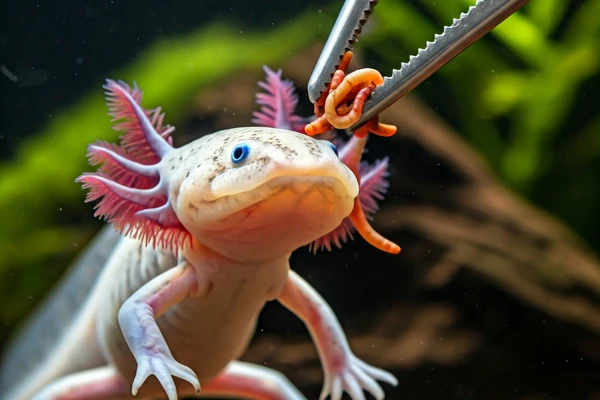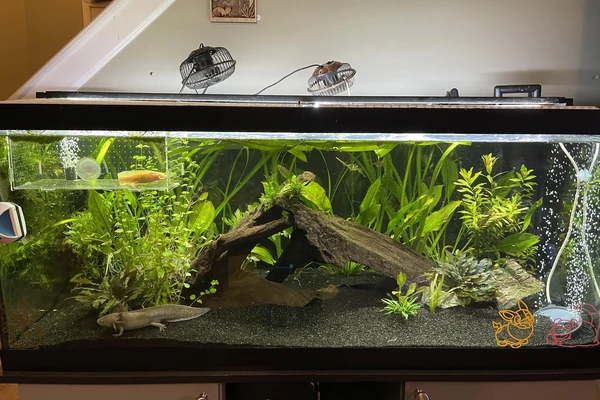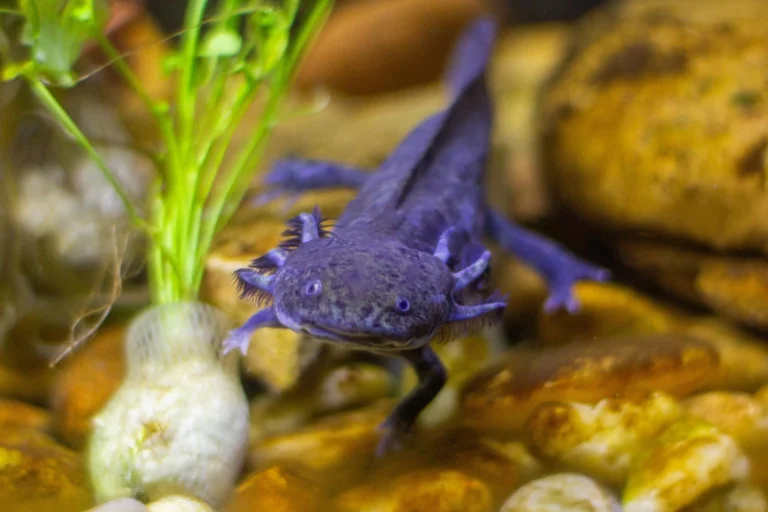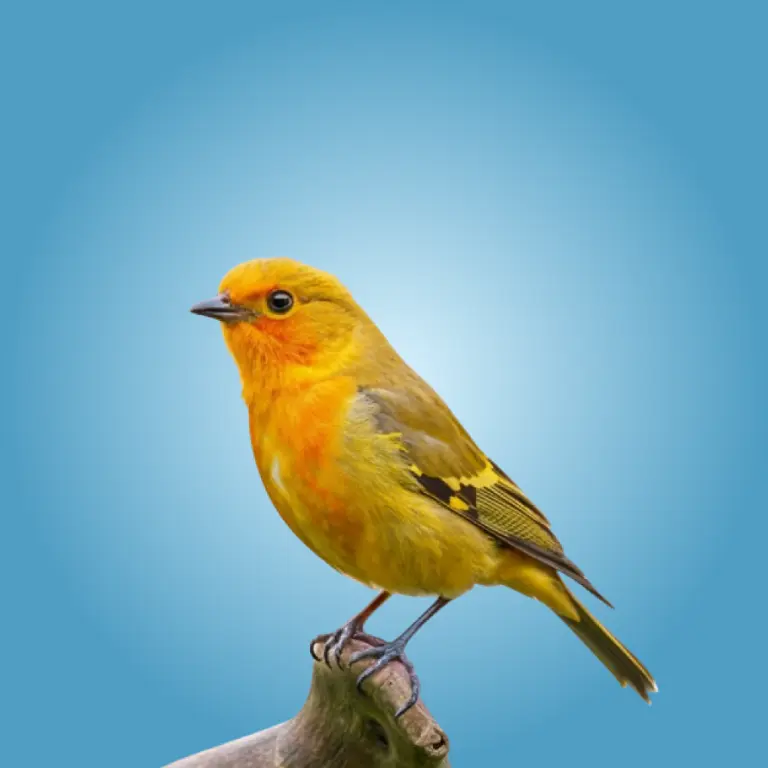Caring for an axolotl isn’t so hard as people seems to be, often called “walking fish,” though they’re actually amphibians.
If you’ve ever thought about owning one, you’re in for a ride .
But let me tell you, caring for an axolotl isn’t as simple as placing it in a bowl of water.
These adorable little salamanders have specific needs that must be met to keep them healthy and happy.
so lets find some answer so that you dont have to!
1. Setting Up the Perfect Tank
The first step in caring for an axolotl is creating a comfortable home. Axolotls spend their entire lives in water, so their tank setup is critical.
Tank Size:
Aim for a 20-gallon tank at minimum. While axolotls don’t swim long distances, they do need space to move around. Make sure the tank provides enough room for them to explore and relax.
Water Temperature:
Keep it cool! Axolotls thrive in water temperatures between 60-64°F (16-18°C). Too warm, and they’ll become stressed; too cold, and their metabolism slows down.

Filtration:
Use a gentle filter. Axolotls dislike strong currents, so pick one that won’t disturb their serene environment. This ensures they remain calm and stress-free.
Substrate:
Use fine sand or keep the tank bare-bottomed. Avoid gravel, as axolotls can accidentally swallow it, leading to dangerous blockages.
Think of the tank as your axolotl’s sanctuary. Taking the time to set it up properly will save you headaches and keep your axolotl safe.
2. Maintaining Clean Water
When I first cared for an axolotl, I quickly learned that water quality is everything. Poor water conditions can lead to illness, so this is a step you can’t afford to skip.
Cycle the Tank:
Before adding your axolotl, ensure the tank is cycled. This means establishing beneficial bacteria to manage ammonia and nitrite levels. This process can take a few weeks but is essential.
Test Regularly:
Invest in a reliable water testing kit. Ammonia and nitrite levels should be at zero, and nitrate levels should stay under 20 ppm. Regular testing keeps your axolotl safe from harmful toxins.
Weekly Water Changes:
Replace about 20-30% of the tank water weekly to keep it fresh and clean. Remember to use dechlorinated water. Clean water is the foundation of their health.
3. Feeding Your Axolotl
Feeding time is one of the most fun parts of caring for an axolotl. Their diet is simple, but it’s crucial to get it right.
What to Feed:
Axolotls love earthworms, bloodworms, and pellets designed for carnivorous fish. Occasionally, you can offer treats like brine shrimp. Variety keeps their diet balanced.

How Often:
Feed adult axolotls 2-3 times a week. Juveniles need daily feeding because they’re still growing. Stick to a consistent feeding schedule.
Portion Size:
Give them food they can eat within 2-3 minutes. Overfeeding can lead to obesity and water quality issues. Moderation is key to keeping them healthy.
Watching an axolotl eat is mesmerizing—their little gulping motions are just adorable. Plus, knowing they’re well-fed gives you peace of mind.
4. Handling and Interaction
Here’s the thing: axolotls aren’t cuddly pets. They prefer to be left alone in their watery world. However, that doesn’t mean you can’t enjoy interacting with them.
Avoid Handling:
heir skin is delicate and coated with a protective slime layer. Touching them can cause harm. Always prioritize their well-being by keeping them in the water.
Observe and Interact:
Spend time watching them swim, feed, or just hang out in their tank. They’ll quickly learn to associate you with food and may even come to the glass when you approach. These moments create a unique bond.
Building a bond with your axolotl is more about observation than physical interaction. Trust me, their quirky behaviors make them endlessly entertaining.

5. Monitoring Their Health
One of the scariest moments for any axolotl owner is noticing something wrong with their little friend. But with proper care, most health issues can be prevented.
Signs of Good Health:
A healthy axolotl will have smooth skin, clear eyes, and fluffy gills. They should also be active and eating well. Regular observation helps you spot potential problems early.
Common Issues:
Look out for fungal infections (white patches), ammonia burns (red skin), or signs of stress like curled gills. Prompt action can make all the difference.
Quick Action:
If you spot any issues, test the water parameters immediately and consult an vet if needed. Don’t hesitate to seek professional help.
You’ll feel so proud every time your axolotl glides through the water, knowing you’ve done everything to keep them in great shape.
6. Enriching Their Environment
Axolotls may seem low-maintenance, but they do benefit from some enrichment.

Hiding Spots:
Add caves, PVC pipes, or plants for them to explore. They love hiding away from bright lights. A variety of spots keeps them entertained.
Lighting:
Keep the tank dimly lit. Axolotls are sensitive to light and feel more comfortable in low-light settings. This ensures they remain stress-free.
Toys and Decor:
Floating items or gentle bubbler features can add interest to their habitat. Small additions can make a big difference.
Creating an engaging environment will bring out their natural behaviors and make you smile every time you watch them.
7. Understanding Their Unique Needs
Finally, caring for an axolotl means appreciating their uniqueness. Unlike most amphibians, axolotls stay in their larval stage throughout their lives. This means they’ll always have gills and live underwater. Isn’t that amazing?
Remember, you’re taking care of a one-of-a-kind creature. With their wide smiles and quirky movements, axolotls bring endless joy to their owners.
Final Thoughts
Caring for an axolotl is a rewarding experience, but it’s not for everyone. It takes time, effort, and a willingness to learn. But if you’re ready to commit, I promise the journey will be worth it. From setting up their tank to watching them thrive, you’ll feel a deep sense of satisfaction knowing you’ve created a happy, healthy life for your little aquatic friend.

















